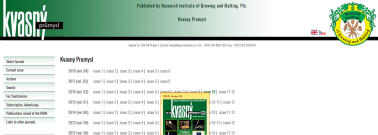Gushing Induced by Colloidal haze
DOI:
https://doi.org/10.18832/kp2016017Keywords:
gushing, headspace, pressure growth, overflowed volume, gushing induction, proteins, tannins, microbubblesAbstract
The tendency to beer gushing can be determined by measuring the pressure growth in the head space after piercing the bottle crown and closing this puncture again. The important parameter is the initial value of the rate of pressure growth (kPa/min), or a pressure value reached after 1 min after crown puncture resealing which is called PG1. Beer value PG1 > 50 kPa is considered to be typical for starting gushing while value above 120 kPa is associated with strong ejection or overflowing beer from the bottle. Gushing could be also induced in beers which showed no gushing even after long periods of storage (up to 11 months) at rest after their subsequent shaking. Increasing storage and shaking time increased the probability of overfoaming. Haze forming substance such as tannin, gelatine and their combination managed to induce gushing that was supported by shaking. Therefore, we assume that gushing may also arise from compounds, naturally occurring in beer, such as proteins and polyphenols.







